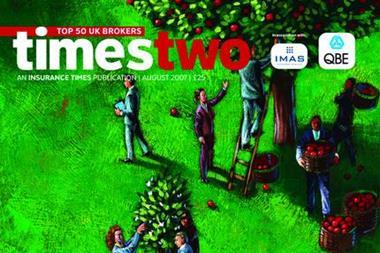Revenue growth is still strong as consolidation impacts the lower third of the Top 50, but the top tier are losing ground. James Simpson reports
This year finally achieves what has been talked about for the past five years – consolidation of the general insurance market. The IMAS consolidation graph (The cumulative share of revenue) has finally gone positive, starting in the middle order of the Top 50.
Acquisitions over the past year have been numerous, across a large range of sizes and plenty more are going to happen in 2007.
But it is not all merger and acquisition led, organic growth has played its part, especially in the personal lines sector where growth remains at the same level as last year, 17%, with a limited number of acquisitions.
Growth rates in the commercial sector have slowed from last year’s almost 40% to this year’s 33% – still high, but just not so high. London and the international brokers continue to see stagnation, primarily due to the weakness of the US dollar and soft international rates. And there is little sign of any prospect that these conditions will change.
Market consolidation
Total revenue for the Top 50 has seen the first real growth since we started charting the income in 2002 and we really see the consolidation impact from 17th place onwards.
The international brokers in the Top 10 have in aggregate lost ground against the rest of the Top 50 and much of this is down to the weakness of the US dollar – JLT estimated that it cost it £11. 6m in revenue. This drop in revenue assists the middle order UK players to gain a larger share of the Top 50 income, possibly overstating the extent of the real consolidation.
There is one notable absentee this year – Primary – which has stated that it is now primarily an MGA and that its broking businesses process predominantly internal business.
The recognised consolidators have however continued apace as well as being joined by insurers, AXA and Groupama.
Both insurers have spent considerable funds in securing their chosen parts of the distribution market. AXA has focused on SME commercial,while Groupama has gone for motor – motorcycles to commercial motor. We wait to see who comes out of the pack next to defend/secure their distribution.
Amlin has peeked out with its modest acquisition of AUA, although this is more wholesale/ underwriting than mainstream distribution.
“The international brokers in the Top 10 have in aggregate lost ground to the rest of the Top 50
The merger of the AA and Saga will create a significant business, but as we have traditionally not included Saga as a broker in our table (along with the banks we view it as a distributor of a non-brokered product) the consolidation effect of this is not apparent in our analysis.
Lockton’s purchase of the Alexander Forbes business has also caused some de-consolidation as the financial services business is no longer part of the continuing entity that we have analysed for the table.
Growth rates
As noted above the highest growth rates have been almost entirely driven by acquisition. There are however some exceptions notably Group Direct, BGL and RK Harrison. These businesses have achieved excellent organic growth (along with some acquisitions) to rank them in the 2007 Top 15 fastest growing companies. Given BGL’s size, a 38% growth factor is a volume of business that many of the other companies would have readily welcomed.
Group Direct has landed itself in the Top 50 for the first time after achieving excellent growth in its chosen motor sectors, demonstr-ating the benefits of focus over generalism.
Kwik-Fit has grown very well through a mixture of organic and acquisition, it achieved almost 20% organic growth and has recently added the same again through its acquisition of Express Insurance
The top fastest growing acquisitor is Giles with a 133. 3% growth factor on an annualised income basis, followed by the Broker Network, albeit both from a smaller income base than most other consolidators.
In terms of absolute income growth it is of course Towergate that comes out at the top of the pack with an increase of over £68m in income. Next is Oval with £21m having just completed the acquisition of Williamson Moore on the south coast.
But, as we know, income growth is not the be all and end all of success – profitability is what really generates the value.
Profit margins
We analyse profit margins from two angles, first is the margin itself and those that have made significant improvements, the other is through income per employee as staff costs are by far the largest factor in driving the cost base of a broking business.
“There have been some startling improvements in profits margins over the past year with six companies improving theirs by over 100%
There have been some startling improvements in profits margins over the past year with six companies improving theirs by over 100% and only one of those is after a prior year restructure of the business, HL Group.
The two largest improvers are contrasting businesses, the AXA consolidator Venture Preference and the AA Insurance Services. The Venture Preference figures benefit from the consolidation of the three major entities that make it up and the emergence of the benefits of their prior acquisitions.
The AA’s margin improvement is generated from a reasonable increase in income flowing straight thorough to the bottom line as costs were kept tightly under control.
Other consolidators also appear in the Top 10 margin improvers, Oval and Giles, showing that being an acquirer is not all about top line.
Increases in income per employee shows a slightly different picture and we may expect to see these companies in the margin improvers next year.
Leading the pack is Jelf, closely followed by Group Direct. Jelf’s figures benefit from having full year figures for its 2005 acquisitions as well as its 2006 being highly productive businesses.
Group Direct’s increase underpins its use of systems and focus to run a higher volume business during a period of rapid sales growth.
It is highly commendable that the next best improvers are substantial businesses, Budget and the AA, both personal lines and both who have improved rewards from insurers and utilised systems to keep headcount under control.
It is also interesting to note that five London market brokers make an appearance in this Top 10 improvers. RK Harrison has a unique model with highly motivated teams focused on achieving profits and thus keeping their costs under very tight control.
AHJ has shown that growth can be achieved in London without having to acquire, working at what you are good at will produce results.
Coleman Group, Gallagher and THB have all achieved improvements in income per employee which have made a real difference to their profits, although not enough to get into the top improvers.
“Simply saying that goodwill in the balance sheet is a bad thing is far too basic there is no alternative to having goodwill if one is going to acquire businesses in this sector as so much of the value of the business is intangible
Goodwill
There has been a lot of talk about how goodwill is going to be treated from 2008 onwards; much of this has been focused on the UK commercial sector and the medium sized brokers that acquired businesses over the last five or 10 years.
Yet if you look at the Top 50 table you will see that a number of the brokers at the top end have a similar if not more difficult question to answer if the commentary is accurate.
JLT and Benfield, both UK listed companies have goodwill in their balance sheets equivalent to almost 100% of their shareholders funds. BGL, a very impressive financial performer, has goodwill of 163% of its shareholders funds. Lockton has 600% and Towergate tops the lot with almost 1,500%.
I am not even sure I want to contemplate what the new holding company accounts for Saga and the AA will look like after their merger given the values being talked about, and then there is Venture Preference and IAG.
Obviously simply saying that goodwill in the balance sheet is a “bad thing” is far too basic – there is no alternative to having goodwill if one is going to acquire businesses in this sector as so much of the value of the business is intangible.
What has to be looked at is the financial performance and stability of the business in relation to its commitments. If the goodwill is not in the FSA -regulated entity then the failure of that company does not necessarily adversely impact the sound operation of the regulated trading entity.
This does not address how a single company broker that has goodwill in its balance sheet, having acquired a book of business, goes about dealing with its issue. But it seems anti-competitive to push them into the hands of the consolidators.
Creating a new subsidiary and transferring the business down into that company is one way but will require FSA authorisation for the new company.
A fairer way perhaps is to listen to what the plans are of the company to reduce its goodwill through amortisation, so long as these are realistic then that should deal with the issue and not drive choice and independence out of the UK market.
Downloads
Top 50 Brokers 2007 - PDF
PDF, Size 6.59 mb
Postscript
James Simpson is a principal at IMAS Corporate Advisors
Hosted by comedian and actor Tom Allen, 34 Gold, 23 Silver and 22 Bronze awards were handed out across an amazing 34 categories recognising brilliance and innovation right across the breadth of UK general insurance.








































